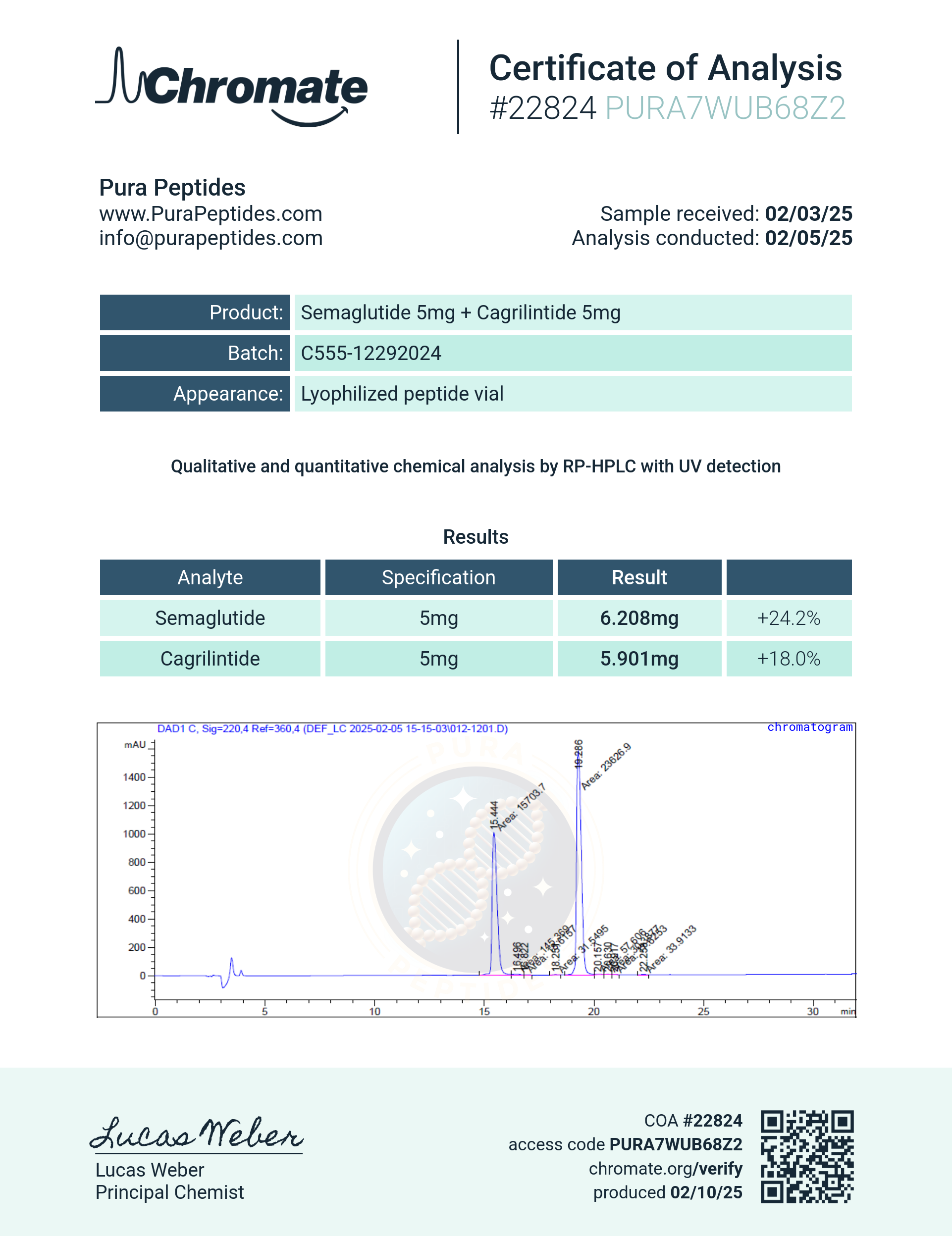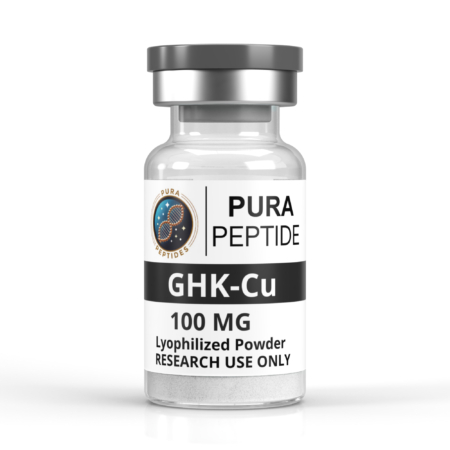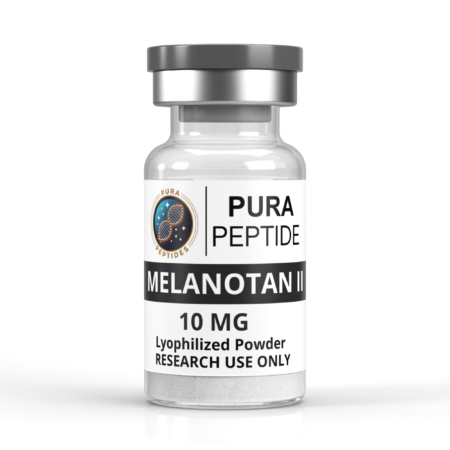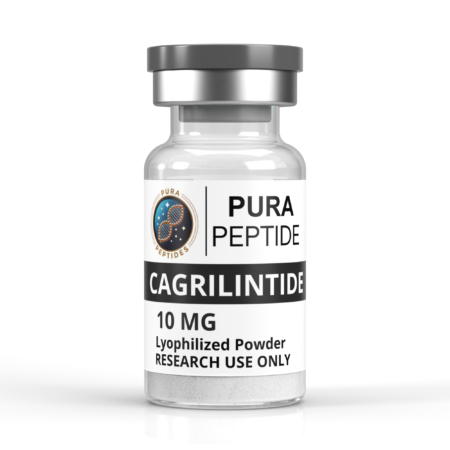Theoretical Analysis
Theoretical Analysis of CAG-SEMA
CAG-SEMA, a combination of cagrilintide (an amylin analog) and semaglutide (a GLP-1 receptor agonist), offers a unique theoretical framework for understanding metabolic regulation, specifically in the areas of weight management and glucose homeostasis. Both compounds individually have demonstrated therapeutic potential in managing obesity and type 2 diabetes, but their combination could provide more effective insights into the physiological mechanisms underlying these conditions.
1. Mechanism of Action
- Cagrilintide (Amylin Analog): Amylin, a naturally occurring hormone secreted alongside insulin, plays a significant role in regulating appetite, gastric emptying, and postprandial glucose levels. Cagrilintide mimics the action of amylin, which promotes satiety and slows gastric emptying, theoretically reducing overall calorie intake and supporting weight loss. By increasing feelings of fullness, cagrilintide could influence eating behavior and contribute to sustained weight reduction in metabolic disorder research.
- Semaglutide (GLP-1 Receptor Agonist): GLP-1 (glucagon-like peptide-1) enhances insulin secretion in a glucose-dependent manner, suppresses glucagon release, and slows gastric emptying. Semaglutide, a GLP-1 analog, mimics these effects, leading to improved blood sugar control. Additionally, semaglutide has been shown to reduce appetite, promoting weight loss through its effects on central nervous system pathways involved in hunger regulation.
2. Synergistic Effects
When combined, cagrilintide and semaglutide may offer a synergistic effect that targets multiple aspects of metabolic dysfunction. The dual modulation of appetite and blood glucose could offer more comprehensive control over body weight and glucose levels than either compound alone. This combination could potentially reduce the risk factors associated with obesity and diabetes by:
- Enhancing satiety more effectively, leading to reduced caloric intake.
- Improving glucose tolerance, potentially reducing insulin resistance and lowering HbA1c levels.
- Lowering the risk of hyperglycemia and weight gain due to the combined effects on glucose regulation and appetite.
3. Potential Research Applications
The theoretical analysis of CAG-SEMA suggests it could be a powerful tool for understanding metabolic diseases and testing potential treatments. Some key areas for investigation include:
- Obesity Research: Investigating how CAG-SEMA influences long-term weight loss through appetite regulation and satiety.
- Type 2 Diabetes: Studying the compound’s effects on glycemic control, insulin sensitivity, and HbA1c reduction.
- Hormonal Interactions: Exploring how the interaction between amylin and GLP-1 affects appetite control and glucose metabolism in concert.
- Combination Therapies: Analyzing the possibility of using CAG-SEMA as a part of combination therapies to address metabolic diseases more comprehensively.
4. Theoretical Benefits Over Single-Agent Therapies
- Enhanced Efficacy: By combining two distinct pathways that regulate appetite and glucose metabolism, CAG-SEMA may offer enhanced efficacy compared to single-agent treatments. The combined effects of amylin and GLP-1 receptor agonism could potentially lead to greater reductions in body weight and blood sugar levels in research studies.
- Reduced Side Effects: The dual action may allow for lower doses of each individual compound, potentially reducing the incidence of side effects commonly associated with higher doses of single therapies.
5. Future Directions
Further research is needed to explore the full potential of CAG-SEMA. Investigating the compound’s effects in different animal models, clinical settings, and as part of combination treatments could unlock new avenues for treating obesity, type 2 diabetes, and related metabolic conditions.
In conclusion, CAG-SEMA represents a promising theoretical approach to studying and understanding the complex interactions between appetite regulation, glucose metabolism, and weight control. Its dual-action formulation could lead to significant advancements in the treatment of metabolic disorders, but continued research is essential to fully elucidate its mechanisms and optimize its use in therapeutic applications.
Product Usage
Product Usage for CAG-SEMA (For Research Use Only)
CAG-SEMA is designed for use in controlled laboratory settings to support research in metabolic health, including studies on obesity, weight management, and glucose regulation. It is not intended for human or animal consumption. Researchers should follow appropriate protocols for handling and administration in accordance with regulatory guidelines.
Recommended Usage Instructions:
- Preparation:
- CAG-SEMA is supplied as a concentrated solution (or powder, depending on the form).
- Prepare the solution according to the instructions provided by the manufacturer, using sterile techniques and appropriate solvents, if necessary.
- Ensure proper storage conditions as outlined in the product’s data sheet to maintain stability and efficacy.
- Dosage and Administration:
- The exact dosage and administration protocol will depend on the specific research objectives and experimental model being used.
- For animal studies, the dosage should be determined based on the weight of the subjects and the research goals.
- Administer via the preferred method as per your laboratory’s standard operating procedures (e.g., injection, oral dosing).
- Use in accordance with ethical guidelines for animal research and ensure proper monitoring of subjects during the study period.
- Monitoring and Adjustments:
- Continuously monitor research subjects for any adverse effects, and adjust dosing as necessary based on the results of initial trials.
- Record changes in weight, glucose levels, and other relevant biomarkers in accordance with the research objectives.
- If the product is being used in combination with other research agents, assess the interactions between the compounds carefully.
- Safety Precautions:
- Wear appropriate protective equipment (e.g., gloves, lab coat, safety goggles) when handling CAG-SEMA.
- Follow all safety data sheet (SDS) guidelines for safe handling, storage, and disposal of the product.
- Always handle CAG-SEMA in a controlled, well-ventilated area, and dispose of any waste materials in compliance with local regulations.
- Storage:
- Store CAG-SEMA in a cool, dry place, away from direct sunlight, as indicated by the manufacturer.
- Keep the product tightly sealed to prevent contamination or degradation.
- If applicable, store in a refrigerated environment, but avoid freezing unless specified by the manufacturer.
- Research Application:
- CAG-SEMA is designed for use in in vitro or in vivo studies aimed at understanding the combined effects of cagrilintide and semaglutide.
- Potential applications include metabolic disease modeling, weight management studies, and glucose regulation research.
Important Notes:
- CAG-SEMA is for research use only and is not for human or animal consumption.
- Ensure that all research complies with applicable ethical standards and regulatory requirements.
- Always consult the accompanying research documentation and protocols for more detailed guidance on the usage of CAG-SEMA in specific experiments.
By following these guidelines, researchers can utilize CAG-SEMA to explore innovative solutions for addressing metabolic health challenges.









